




















The team is building a temporary trestle on the east and west sides of the river for access to the approach land-based work, south of the existing bridge, as the river’s edges can only be accessed from the north side of the existing tracks.

By Larry Bernstein CEG CORRESPONDENT
Constructed in 1907, the Connecticut River Bridge connects the towns of Old Saybrook and Old Lyme. In summer 2024, the O&G/Tutor Perini Joint Venture team broke ground on the new Connecticut River Bridge, which is
expected to be completed in summer 2030. Amtrak notes that more than 60 Northeast Regional and Acela trains, CTrail Shore Line East commuter service trains and freight trains cross the 117-year-old 1,600-ft. bridge daily. While the wood-supported bridge is serviceable, it’s at the end of its useful life.
When last year’s winter storms devastated the Maine coast, Sam Belknap’s family wharf on Round Pond Harbor in Bristol was saved by its concrete floor.
The surface, which his family poured years ago when they put in a seafood processing room, provided enough weight to keep most of the wharf from floating away.
As the state braces for more storms in the future, Belknap sees the concrete floor as an example of resilience technology at work.
More than a year after a series of December 2023 and January 2024 storms caused an estimated $90 million in damage to coastal communities in the state, Maine is moving to strengthen its preparedness and resiliency for more destructive tempests in the years ahead.
Jessica Reilly-Moman, director of climate and community


















SENNEBOGEN, in kee philosophy to maxim created UPTIME Kits
eping with their mize uptime, has Whether you are a service technician i road, these kits have need for every service and PM task in one p created to save you t Managing hundreds o parts, from belts and and special tools bec single part number to n-house or on the everything you e, maintenance place. They were ime and money.


They are:
































• Easy to order and ea t d t ockst asy to s l dow NO I th Norour intspar om c with omerscust
• Ideal for stocking se and trucks
Choose from the follo
• Central lubrication
• Preventive mainte
• O-Ring kits
• Electrical service k
• Hydraulic service k
Hydraulic service k : kits shops ols ervice owing kits system kits nance service kits its kits
And the best thing is in stock and ready to built to match your m and series. Count on
in-house. For more in UPTIME Kits, scan th
s that these kits, go, are custommachine model SENNEBOGEN nformation on he QR code.


e orf ) OCT(Ownership of






of related service d nuts to O-Rings omes easy with a o order and stock C OND YBE E H HE HIN T MA virtua lI entim lose llyt



























































xim ma ommitmentc h about e morad ontract Demolition C parepairtsinsthavether andvirtuinanothermachineI onttoback.If very e ctomehavea Theyechnician machine, wntim w American o-shiptady- of oriesinventplete orf uptime izes aftersale achine”M he yond “Beour ow , Bloomfield Hills, MI or theunitbackquickly. kIg losedonoSinctheey ally Ihaveasituation,[they]bringjust ogooverthroncougheamontht wntime… ock.get theSENNEBOGEN y-t t act OGEN f tor ained technicians tr ned tec cians components and too





The vote was more of a delaying action and a protest because it only stops the transportation agency from immediately pushing back the project.
Fed up by years of delay, the board of the 19-town Naugatuck Valley Council of Governments (NVCOG) in Waterbury, Conn., has sent a message to state transportation planners voting to oppose another postponement of an estimated $35 million project to reconstruct the interchange of Connecticut Highway 63, Conn. 64, and Interstate 84 on the Waterbury-Middlebury line.
The unanimous vote on Feb. 21, 2025, adopted an unusual staff recommendation to reject a proposal from the Connecticut Department of Transportation (CTDOT) to remove the long-planned project from its latest three-year capital plan.
Generally, past requests to amend such transportation improvement plans have been accommodated, but the Waterbury Republican-American reported Feb. 26, 2025, that frustrations over this project’s timeline led to a different outcome.
CTDOT proposed to move the interchange reconstruction project from the current fiscal year’s construction list to some undetermined future year and push it out of a short-term capital plan. Transportation planners also have determined that updated traffic volume data is required for the final design.
The NVCOG vote was more of a delaying action and a protest because it only stops the transportation agency from immediately pushing back the project, but does not mean the effort will be moving forward any time soon.
The action primarily registered the frustrations of the member towns and staff of the NVCOG, perhaps none more than long-time Middlebury First Selectman Ed St. John.
“I’ve been dealing with this project since 1976,” said St. John. “This is one project that I’m sure is going to outlive me. I have outlived some of the others, but this one is going to be just the opposite. I’m so frustrated with

CTDOT proposed to move the interchange reconstruction project from the current fiscal year’s construction list to some undetermined future year and push it out of a short-term capital plan.
“I’ve been dealing with this project since 1976. This is one project that I’m sure is going to outlive me. I have outlived some of the others, but this one is going to be just the opposite.”
Ed St. John Middlebury First Selectman
this whole thing. It is just kicking the can down the road … and it just keeps going on and on … and goes nowhere.”
NVCOG’s Rick Dunne and Rich Donovan, its executive director and the transportation planning director, respectively, told the Waterbury news source that the rejection of the CTDOT request will provide additional time to get more information on the road project’s timeline from the state agency.
“This project has been going on for a very long time and it has been delayed many times, so it may not be a terrible idea to show that we are frustrated about the ongoing delays and would like to see a real commitment to when this project [could] move forward,” Donovan said.
The interchange improvements involve widening sections of Conn. Highways 63/64, constructing a new road to connect Chase Parkway with Conn. 63, building a multiuse trail to connect the Middlebury Greenway, widening an I-84 off-ramp to Chase Parkway and altering and adding traffic lights throughout the project’s footprint.
In addition, a new commuter parking lot is planned with the purpose of addressing safety and operational concerns associated with traffic delays and crashes with the interchange zone.
Although the estimated construction cost is $35 million, there is — as yet — no confirmed funding, according to the CTDOT capital plan.
The Republican-American learned from Donovan that construction was scheduled to start in Q2 2025 fiscal year, but the transportation department determined that updated traffic volume and turning movement data is required before the project can move to the final design stage.
As a result, CTDOT is proposing to remove the project out of its current capital plan and include it in some future one.
Donovan said this would be the third time that the interchange project has been shuffled in and out of a short-term capital plan by CTDOT. He added while there is no objection from NVCOG to the state agency getting updated traffic volume and pattern data, the concern is that there is no commitment for when the project will move forward.
The council’s motion to reject the transportation department’s proposal also requested further collaboration with CTDOT officials regarding the interchange project’s timeline and scope.
“Hopefully, we’ll get a response,” Dunne said in speaking with the Waterbury newspaper.


















RD12
Tandem Roller
Offering a wide range of compactors that are designed to help you get the job done quickly, efficiently, and safely!
RTLx-SC3
Remote Control
Trench Roller
Delivering Durable, Dependable and Easy-To-Use Equipment!
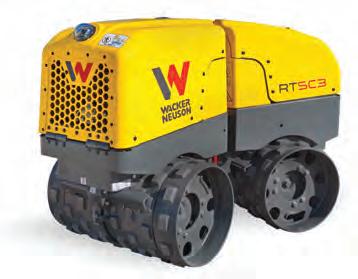
• Local Ownership with flexible approach
• Trained staff for repairs and maintenance
• Dedicated Parts personnel on site

SM100 Utility Track Loader

Trench rollers, 1-ton Paving Rollers and Small Utility Track Loaders
• Focused on the Heavy Construction Industry
• Providing the BEST support equipment available
• Experienced outside sales staff
Construction on the Ogunquit, Maine’s new municipal campus on School Street is continuing, although town officials are scaling back certain aspects of the project to stay within the $11.9 million budget.
Ogunquit Town Manager Matthew Buttrick said that recent perceptions of the project being over budget by a million dollars may have stemmed from “misconstrued” discussions about costs and scope.
“The project is not over budget,” he explained to the Herald, a news source based in nearby Portsmouth, N.H. “The budget itself remains fixed. What varies is the scope of what we can achieve within that budget. As with all large projects, there are multiple stages of plan development and cost estimation, which help us refine the project as we move forward.”
Buttrick said adjustments to the town hall project have included reducing the square footage and footprint of new construction and reining in the original vision for the renovation of the coastal community’s Dunaway Center.
“Throughout this project, we have worked diligently to reduce costs and valueengineer each component to stay within
“Throughout this project, we have worked diligently to reduce costs and valueengineer each component to stay within budget.”
Matthew Buttrick Ogunquit Town Manager
budget,” he added. “The budget for the new building has not and will not be exceeded.”
Approved by voters, the work involves building a new, fully functional town hall and police department, installing a new basketball court and playground, performing landscaping and renovating the nearby Dunaway Community Center to make it more comfortable and accessible, according to Buttrick.
During construction, the Ogunquit Police Department is temporarily stationed at 102 Main St., the Herald noted in its Jan. 29 article.
Regarding the Dunaway Center, that part of the overall project was retooled to focus
on repairs and maintenance after design estimates related to the basement exceeded the allocated amount of $2.5 million, even after an initial reduction in scope had been made, Buttrick told the newspaper.
“Bringing the building entirely up to code would have required replacing the electrical system — an expense of $700,000 — and gutting the building,” he elaborated. “Instead, we opted for repairs and maintenance, allowing us to improve the building without triggering full code compliance requirements.”
Buttrick also said that fundraising for the exterior features of the project, such as the new basketball court, retaining walls, landscaping, and more, did not meet initial expectations. The amount raised was $150,000, which he noted was “significantly short of our goal.”
“As we refined the project and received bids, site costs increased to over $2.4 million,” Buttrick continued. “To address this, we scaled back the playground design, including reusing equipment from the previous playground, but we still face a shortfall of $1.5 million.”
Crews will begin interior upgrades at the Dunaway Center that will allow staff mem-
bers to continue working inside the building. The work will include replacing the building’s oil furnace and the auditorium’s air conditioner, as well as upgrading the meeting room with a new camera and broadcasting system.
“Once the building is vacated, the foundation will need to be waterproofed, which will involve excavation, installation of a water diversion system, and application of waterproofing materials,” Buttrick explained.
“ADA-compliant stairs and ramps will also need to be installed.”
The town’s staff is likely to vacate the Dunaway Center in December 2025, he said, adding that Ogunquit is presently working in the final design phase for the center’s overall renovation.
At the moment, crews are working on the construction of the new town hall and police department on School Street. Additionally, the designs for the new playground and basketball court to be installed on the campus are being finalized.
In speaking with the Herald, Buttrick said the new Ogunquit Town Hall is scheduled to be complete — and ready to be occupied by staff — by mid-November, although site work and landscaping is expected to continue into the spring of 2026.

pe an XP L L erformancerobustdesignan n integrated, innovative mach Power® is the new generatio - L Powwer® 550 X o o heel L iebherr W
s large wheel loa ’s n of Liebherr Powwer® 586 X o
hine concept that sets new st
ndcomfortTheXPower®po
r. re dle more, faster wheel loaders adjusts the p , whatever the applica y,fficiency -split driveline combines r-
splitdrivelinecombines r ower y, ds in terms of r andar eliability ders. Liebherr XPower® is to the job for fuel savings of up r--Efficiency r- The Liebherr-Power ostatic with mechanical dr hydr obust design an performance, r cent - so you hand p to 30 per (LPE) System of the XPower® es maximum ef re rive and ensur nd comfort The XPower® po


Downtown Montpelier, Vt., is beginning a major construction project on State Street.
The effort, expected to last through June 2025, will extend northwest from the intersection of State and Main streets to the Rialto Bridge over the Winooski River on State Street.
Its goal is to separate stormwater coming from East State Street out of the sanitary sewer system, which contributes to combined sewer overflows during heavy rain, said Justin LaPerle, engineer of the Montpelier department of public works (DPW).
Since no existing stormwater outfalls are large enough to handle runoff from East State Street, the project will create a new outlet, LaPerle said in an interview with the Montpelier Bridge, a Central Vermont online news site, for an article published March 10, 2025.
State Street will only be open to westbound traffic, heading toward the Vermont Statehouse, between Main and Elm streets, for several months. Because of the fluid nature of construction projects, the city does not want to put a specific date on the return of two-way traffic.
The Bridge reported that State Street business owners understand the project is necessary but are nevertheless concerned about the potential for economic disruption.
The work was first announced to the state capital city’s business community at a Montpelier Business Association (MBA) meeting in December 2024, said Lauren Parker, the owner of North Branch Café at 41 State St., which she added few people were able to attend “because it’s our busiest time.”
She also said that Montpelier DPW officials did come to the next regularly scheduled MBA meeting on the first Wednesday of January 2025.
“It was a little shocking,” Parker said of the project’s announcement. “It’s the first that any of us had heard of it.”
According to LaPerle, though, “This project was identified in the city’s Long Term Control Plan (published in 2019), which outlines projects needed for combined sewage overflow reduction.”
In addition, he told the Bridge that for the past several months, updates on the design, bid and award process have been shared in the DPW’s weekly newsletter and that its staff met with business owners shortly after the construction bids came in.
Moreover, LaPerle said details concerning car and pedestrian traffic could not be shared until the contractor was chosen. Increased workloads around 2023’s devastating floods in the area also caused the project to be delayed for a year.
The work downtown project has already

been pushed back two weeks by the contractor, Hebert Excavation in Williamstown, Vt., to allow for building inspections of structures potentially impacted by the construction, according to a Feb. 24 e-mail from the Montpelier DPW to the Bridge.
Those inspections, which will be coordinated by city staff members but performed by Vermont Testing, were planned to occur the week of March 10, 2025, the city agency announced earlier in the month.
In the beginning stages of the work on State Street, crews will be on site to install fencing, erect signage and begin saw-cutting the pavement. This will ultimately result in a large pit, running parallel to traffic flow, approximately 50-ft. long, 28ft. wide and 16-ft. deep, according to LaPerle.
Based on information from the contractors, he said the affected section of State Street will be closed entirely to vehicle traffic from April 7 to April 11, 2025, the only complete vehicular closure between Main and Elm streets scheduled for the entire effort.
Excavation and coring behind the Rialto Bridge abutment will start the week of March 24, 2025, followed by sheet pile installation around the perimeter of the pit beginning March 31, 2025, and through the week of April 7, 2025, LaPerle added, start-
ing first on the southern side near the Positive Pie eatery and proceeding counterclockwise to the northern side of State Street near the Capitol Grounds Café.
From inside of the pit, piping will then be pushed toward the intersection of State and Main streets and a trench also will be excavated from the pit to the Rialto Bridge.
Sidewalk access will remain open for the duration of the construction project, except for temporary closures when sheet piles are lifted into the air.
“This is for everyone’s safety,” said LaPerle.
Parker acknowledged that the city faced its own logistical constraints, which affected communication with the public.
“To be fair,” she said, “they’re working hard on this … they didn’t know until they were able to work this out with the contractors. They didn’t know if this would [happen in 2025] or next year. Until they knew what the story was going to be, they couldn’t really tell us.”
Parker added that just the thought of construction on the street has been frustrating to many business owners, but “we know it needs to be done.”
In addition, she is working with others in the State Street business community to secure free parking for the duration of the construction project, although Parker said she is not yet prepared to announce any
specifics in speaking with the Montpelier news source.
“It’s going to be quite the project,” added Jenny Sebold, owner of two different shops on State Street. “We’re already having a hard enough time as it is rebounding from the floods and people not wanting to come downtown.”
While noting that DPW and other city officials are doing their best, Sebold expressed frustration with the lack of communication surrounding the project.
She noted that her floral business — through phone and online orders, weddings and deliveries — has a cushion against a potential drop in the amount of walk-in traffic as a result of the street construction.
“That has me hopeful that we won’t get completely shellacked,” she said. “But I’m worried.”
Shannon Bates, who owns Enna, a café and gelato shop at 14 State St. sporting a sign that reads “Thanks DPW,” said that most of her customers walk over from nearby offices.
In speaking to the Bridge, Bates said that her café will be fine as long as the State Street project is completed on schedule in June, but if it were to continue into July and August, during the height of the tourist season, it could cause problems.
“We don’t know for sure how the project is going to affect our business,” she said. “I do believe, though, the whole community and the city will support us if it does. That has been proven.”


















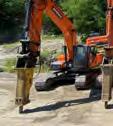











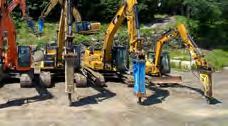




















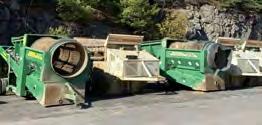




















BRIDGE from page 1
“The new bridge will enhance reliability, resiliency and reduce delays for all users of the bridge, according to Amtrak. “It is designed to support a maximum operating speed of 70 mph, a 55 percent increase from the current maximum speed of 45 mph. Maritime navigation and safety will also improve due to the increased vertical clearance compared to the existing bridge.”
There’s significant maritime activity on the Connecticut River, where the bridge is located (in southern Connecticut). The bascule bridge opens more than 2,800 times annually to allow boats to pass. The Connecticut River Bridge occasionally fails to open and close as designed, resulting in delays for Amtrak and maritime traffic.
“The amount of routine maintenance that Amtrak puts into keeping current bridge functioning is substantial given its age,’ said Peter Spath Jr., senior project manager of O&G Industries. Spath is overseeing the Amtrak project.
The new Connecticut River Bridge will sit 52 ft. south of the existing bridge (centerline to centerline). The move was necessary to give the construction team space to work and not impact the current bridge.
The two-track bridge, projected to have a 100year useful life, will be electrified and movable. It’ll feature “a trunnion bascule span design with modern track, signal, catenary, power, communication and other supporting rail infrastructure.”
As Spath and the team focus on building the new bridge, they have one eye on the old one.
“One of my biggest concerns is that the old bridge continues to function as intended during construction of the new bridge,” he said.
The bridge was built on wood piles, granite piers and abutments.

The team has been (and will continue to be) engaged in prep/site work before construction.
While the age/stage of the bridge is a reason for concern, the more pressing concern is that the construction activities of the new bridge don’t impact the old bridge.
“Construction activities on the new bridge have the potential to impact existing structures,” Spath said. “We will be continuously monitoring the existing bridge’s substructure,
superstructure and tracks to ensure the structure doesn’t move outside of tolerance.”
Should this occur, the team would pause construction of the new bridge, evaluate the old bridge, and take any necessary actions to ensure the old bridge is secure.
The design team, including the consulting engineers, was
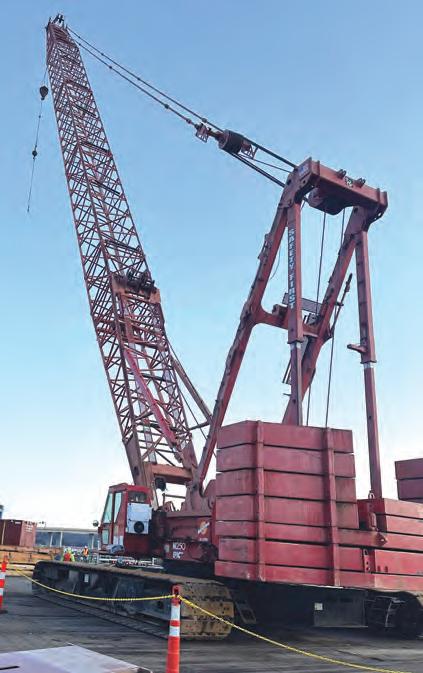
“Construction activities on the new bridge have the potential to impact existing structures,” said Peter Spath Jr., senior project manager of O&G Industries. “We will be continuously monitoring the existing bridge’s substructure, superstructure and tracks to ensure the structure doesn’t move outside of tolerance.”
aware of the sensitivity of the existing bridge. They considered this issue while evaluating the existing conditions and determining where to place the new bridge. Ultimately, the decision to put the new bridge south of the current one was best for both bridges.

The team has been (and will continue to be) engaged in prep/site work before construction. When teams work on water, they typically must engage in environmental tasks depending upon the aquatic and plant life.
“We had environmental requirements that we needed to attend to right out of the gate in order to maintain the schedule,” Spath said.
The team had to treat phragmites and relocate endangered plant species. A delay in handling the environmental requirement would have put them eight months behind until the next planting season.
Getting equipment to and from the site and creating a work area also is part of the prep work. The O&G/Tutor Perini Joint Venture is leasing land near the bridge. The staging/laydown area will be used for temporary storage of materials and subsequent loading onto barges materials and equipment to be used in constructing the new

Since October 2024, construction crews in Providence, R.I., have been hard at work behind Brown University’s OlneyMargolies Athletic Center, digging into the former site of Meister-Kavan Field to pave the way for the school’s future indoor turf facility, a 76,000-sq.-ft., allseason space for practice, training, competition and recreation.
On March 5, 2025, workers hoisted the structure’s final steel beam — adorned with the wellwishes of university leaders, construction workers and community members involved in the project’s planning and development — into position. It was carried aloft in the classic topping-off tradition with an American flag and small pine tree placed atop the beam.
“With this milestone, Brown takes another step toward realizing a key piece of the Brown Athletics vision: A one-of-a-kind, high-performance training venue for our talented student-athletes and our entire campus community,” Brown President Christina H. Paxson said during the event.
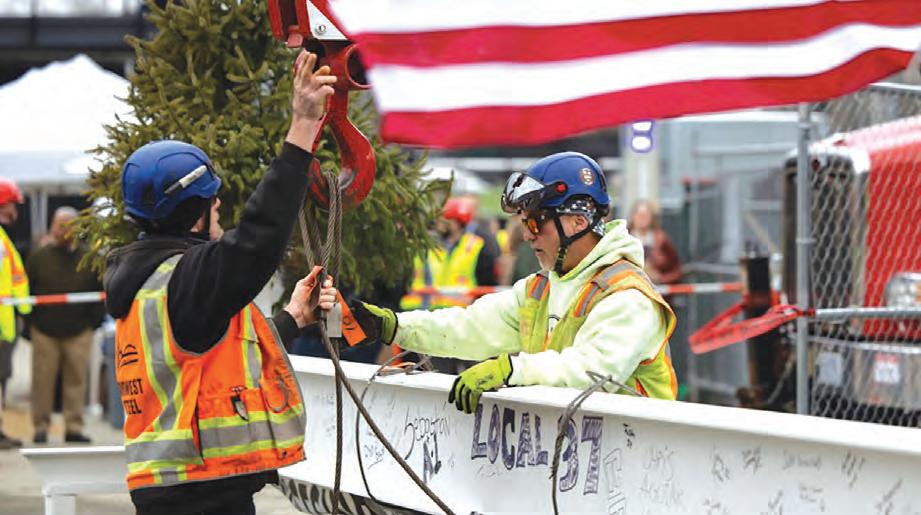
She was joined by Grace Calhoun, the university’s vice president of athletics and recreation, as well as student-athletes, project supporters, skilled laborers and labor representatives from Building Futures and the

Rhode Island Building and Construction Trades Council (RIBCTC) — both of which have long partnered with Brown on its capital improvements.
As workers skillfully navigated the day’s chilly, windy conditions, spectators noted that the weather only served to highlight the need for an indoor turf facility at Brown. In addition to providing a warm, dry space to train for field sports during the winter, the structure will offer a welcome respite from the summer’s heat and humidity.
“This beautiful building will be an absolute game-changer for so many in our community,” Calhoun said.
Funded entirely by donor support, Brown’s indoor turf facility was designed by Sasaki Associates and is expected to open in January 2026, according to a news story on the university’s website.
Consigli Construction Inc. in Milford, Mass., is both the prime contractor and construction manager for the new facility that will replace Meister-Kavan Field, which served as the early-season and inclement weather site for the men’s lacrosse team, as well as hosting many recreational sporting events.
In addition to the benefits the new building will provide Brown community members, the facility will move Meister-Kavan Field’s outdoor activities to an enclosed space, mitigating noise impacts to local neighbors.
The indoor field will not only be lined for football, men’s and women’s lacrosse, soccer and rugby, but provide more than 5,000
Brown students that enjoy varsity, club and intramural sports with a new place to play. Divider curtains also will enable teams to split the field into halves or thirds, allowing for increased flexibility and accessibility. In addition, approximately 2,500 sq.-ft. within the facility will be dedicated to a strength and conditioning section.
Open year-round, the new structure is expected to alleviate scheduling conflicts for varsity teams vying for training space and expand access to the broader Brown community.
During the 2023-24 academic year, the university noted that 92 percent of undergraduate students engaged in athletics and recreation activities. Calhoun said she hopes that number will rise as the indoor turf facility expands capacity to meet a growing demand for recreational programming and fitness options for students, faculty and staff eager to incorporate physical activity into their personal wellness plans.
“Brown’s dedication to supporting the community both on- and off-campus is just one of the reasons Building Futures has collaborated with the university since 2008,” said Andrew Cortes, executive director of the Providence-based nonprofit apprenticeship program, which helps low-income workers build skills and move into fruitful construction careers.
“We have such a strong partnership in place to make sure that when we’re building Brown, we’re building the community,” said Cortes, while noting that of all the apprentice hours spent on the indoor turf facility, nearly half came from Providence residents.
Building on the longstanding partnership, Brown officials signed a landmark agreement in 2022 with Building Futures and RIBCTC that committed the university to employ all-union labor for every campus construction project costing over $25 million.
The agreement also extended the Ivy League school’s existing goal of ensuring that at least 15 percent of labor hours worked to construct those projects are performed by graduates of Building Futures.
“When a project like this happens, it’s not only a state-of-the-art facility for the best institute of higher education that this country has,” Cortes said. “It’s also the opportunity for people to build a career, to build a life, [and] to build their future.”


BRIDGE from page 12
bridge. Six of the nine approach spans also will be preassembled there, and moved onto barges to be floated into place, saving both time and costs.
Many of the craft also will access the water work from this location. The team also is building a temporary trestle on the east and west sides of the river for access to the approach land-based work, south of the existing bridge, as the river’s edges can only be accessed from the north side of the existing tracks.
The team plans on fabricating a 204-ft.-long steel truss Bascule span off site. Upon completion, they’re going to float it into its final position via barge and heavy lift equipment. As mentioned earlier, six of the approach spans also will be floated in place, however three of the spans are being stick-built in place. Spath said this is because the water is either too shallow restricting barge access for floating a preassembled span into place, or there are conflicting structures like the new control house and rear fender system.
It was decided that construction should occur on the south side of the project. The decision means the existing control house on the south side of the bridge must be relocated to the north side. The existing electrical infrastructure, such as submarine cables and the infrastructure signal, also are being relocated to the north side.
The team also is engaged in road work associated with the railroad approaches. The railroad bed must be realigned with the new bridge, which requires new retaining walls and the earthwork associated with these approaches, involving cofferdams, piles and or rock anchors and cast-in-place retaining walls and backfill.
Spath described some of the key work that needs to take place before.
“We have to drill six-foot and eight-foot diameter steel casings into the bedrock to support the east and west abutments, piers and bascule and resting piers. This and the concrete work for the east and west approaches are critical for the new bridge and will require us to monitor the old bridge.”
The team is engaged in geotechnical investigations to check the quality of rock, sediment, and mudline to get a level of detail required for the installation of the foundations for the new bridge. The team also is doing additional boring and probes on the perimeter and landside.
The O&G and Tutor Perini team have a long history of partnership. Their first project was the Baldwin Bridge, just north of the Connecticut River Bridge. The team constructed the four-lane, 2,500-plus-ft.-long bridge 30 years ago. Over this time, the two companies have joint-ventured on 11 projects totaling more than $5 billion across numerous states. In addition to two ongoing projects in California and this Amtrak project, the team recently was selected as the Contractor for the Newark AirTrain Replacement Project.
The joint venture and its management team also have worked with Amtrak on multiple occasions.
“The people overseeing this project and the owner’s rep are a great group of people to work with,” Spath said. “They are always willing to come to the table and get through issues for the benefit of the project.”
The $1.3 billion project is receiving funding from the Federal Railroad Administration (FRA), Amtrak, and the State of Connecticut. CEG
(All photos courtesy of O&G Industries.)

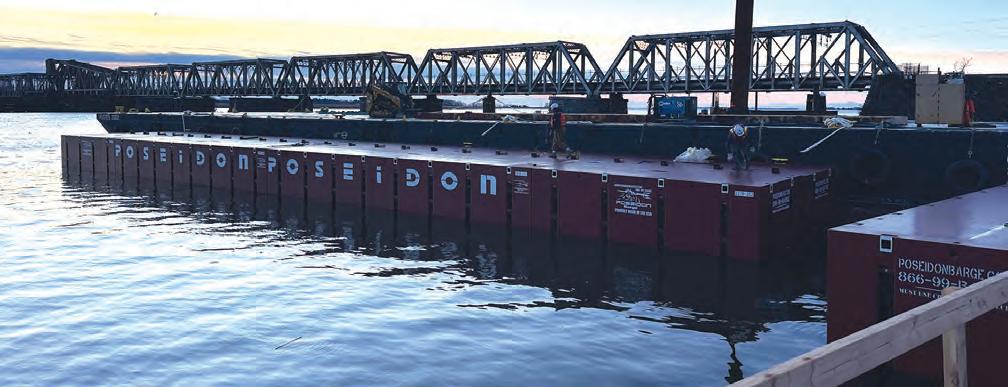


www.equipmenteast.com
61 Silva Lane Dracut, MA 01826
978-454-3320
196 Manley Street Brockton, MA 02301
508-484-5567
1474 Route 3A Bow, NH 03304
603-410-5540


www.barryequipment.com
30 Birch Island Road Webster, MA 01570
508-949-0005
7 Harry’s Way Webster, MA 01570
508-949-0005
1608 John Fitch Blvd South Windsor, CT 06074 860-288-4600
of the Rockland-based Island Institute, said that the storms have prompted a discussion about what is to come.
“It felt like a reckoning moment,” ReillyMoman told The Maine Monitor, a nonprofit online news site. “It became clear that the impacts that coastal communities were facing are new and different.”
Unlike the typical Nor’easters that move through the Gulf of Maine each winter, the three storms that began slamming the coast 15 months ago took the less common Sou’easter track, according to a 2024 report from the Maine Climate Council.
In a warmer world, Sean Birkel, the state’s climatologist, said Maine residents can expect that storms will become more intense, bringing more precipitation when large systems develop. More storms also may take the Sou’easter track, he added, though changes in storm frequency are hard to determine.
“Whether or not we see these more often in a given year or given decade, that’s where there’s a lot of uncertainty,” said Birkel.
He noted that warmer ocean temperatures and sea level rise along Maine’s coast only breed further questions about future storms.
Taking this uncertainty into consideration means shifting from recovery to resilience.
But Belknap, who works as the director of the Center for Marine Economy at the Island Institute, said this shift can be challenging given that even the long-term solutions that seem straightforward for businesses, like putting in a heavy floor, are expensive.
“It’s one of those chicken and egg situations whereby taking the time to truly rebuild towards resilience is often at odds with maintaining a functional and profitable business,” he said in an interview with The Maine Monitor.
For homeowners, other solutions, like building seawalls, can be difficult to do at the scale necessary for community-level resilience.
Easing these challenges is a priority for Maine lawmakers in the 2025 legislative session. In January, Rep. Bob Foley introduced an emergency bill, L.D. 228, to allow property owners to raise coastal seawalls by up to 2 ft. in height.
Current regulations prohibit the construction of new seawalls or additions to existing seawalls within the coastal sand dune ecosystem. The only exception is if new construction is deemed by the state’s Department of Environmental Protection
(DEP) to be less damaging to the sand dune system, wildlife habitat and adjacent properties.
Foley’s bill cites sea level rise for the proposed change, according to The Maine Monitor.
Both Belknap and Reilly-Moman raised questions about the bill, citing it as an example of a “hard infrastructure” approach to mitigation as opposed to nature-based solutions, which supporters believe accounts more holistically for impacts to a coastal ecosystem and surrounding properties.
In contrast, “softer” approaches, such as planting native plants, often struggle to hold up against Maine’s wind and waves.
Walls, however, accelerate erosion at their base and around their edges, worsening the issue in the long run and creating problems for neighbors.
“If one property owner is able to make an investment and their neighbors are not for whatever reason, it is those neighbors that will bear the impact of future storms as a result of that one property investing and protecting itself,” Belknap said.
On Feb. 28, 2025, a bipartisan bill sponsored by Democratic and Republican leadership on behalf of Maine Gov. Janet Mills garnered widespread support at a public hearing.
That bill, designated as L.D. 1, incorporates recommendations made by the state’s Infrastructure Rebuilding and Resilience Commission that Mills established in spring 2024. It proposes three initiatives, which include creating a home resiliency program, launching a state resilience office and “flood-ready” program and enhancing hazard mitigation resources and communications.
The Maine Monitor reported that two of the bill’s initiatives explicitly mention leveraging federal dollars from the National Oceanographic and Atmospheric Administration and the Federal Emergency Management Agency, two agencies whose funding sources have been brought into question amidst ongoing changes to federal spending.
Reilly-Moman said there is a “climate of uncertainty” for those relying on federal grants like the ones FEMA provides. Within the public sector, she told the Hallowellbased nonpartisan news outlet that this presents a chance for the state to consider how it can diversify funding sources to include local philanthropy and businesses.
“The coastal values that we already have are really a perfect fit for this kind of uncertainty,” she continued. “I think that Maine is uniquely positioned to take this as an opportunity.”





